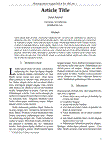| Sumario: | In the state of Sonora, Mexico, several local sciaenids are promising options to diversify the local aquaculture and venture into the marine fish culture industry; however, cost-effective aquafeeds for the development of this farming business are required. Aquafeeds for carnivorous fish, like sciaenids, typically contain high levels of fish meal and fish oil, but the high prices of these dietary ingredients, well above $2000.00 US dollars per ton (aqua grades) in January of 2015, makes the use of high inclusion levels unprofitable and unacceptable. Research work with sciaenids such as the Gulf corvina at the Nutrition Laboratory of the Department of Scientific and Technological Research of the University of Sonora has focused on establishing the minimum dietary lipid requirements as well as the replacement of fish oil, as a starting point. In addition, alternative oil and protein sources, such as ray fish liver oil and tilapia by-products silage, are being explored and evaluated using a sustainable approach. Ray fish constitute an important fishery in the Mexican shoreline, but only their meat is consumed, the rest is discarded. Their liver however, is a rich source of lipids and essential fatty acids. Recent studies showed high lipid levels (30.67-46.41%) in 5 ray species distributed in Sinaloa, Mexico, with a high proportion of unsaturated fatty acids (58-69%), and considerably high levels of eicosapentaenoic (EPA, 20:5n-3) and docosahexaenoic acid (DHA, 22:6n-3) (EPA+DHA= 4.79-14.47 g/100 g of liver oil), thus, ray fish liver oil can be considered an interesting alternative to fish oil as a source of EPA and DHA. Furthermore, aquaculture and fisheries are activities that generate tonnes of by-products. For tilapia, about 30% of the weight is recovered as fillet; the remaining by-products can be processed for the production of silage through fermentation in the presence of Lactobacillus spp. and molasses as a carbohydrate source, which, in turn, can be incorporated as an ingredient in diets for other cultured aquatic organisms, a viable and environmentally friendly usage of discarded remnants of tilapia to generate a value added fish by-product for commercialization. These are some of the first steps leading towards the diversification of the aquaculture industry in Sonora.
|
|---|
